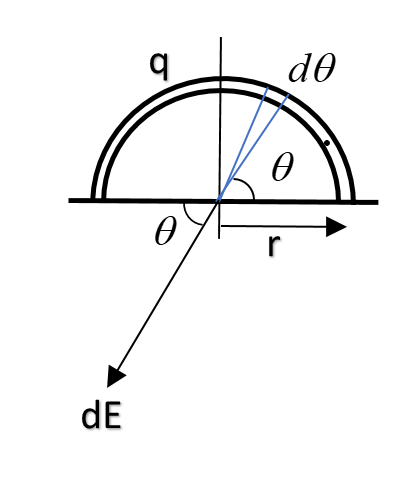Question
Question: A semi-circular ring of radius 0.5m is uniformly charged with the total charge of \(1.4 \times 10^{-...
A semi-circular ring of radius 0.5m is uniformly charged with the total charge of 1.4×10−9C. The electric field intensity at the centre of the ring:
A. 320Vm−1
B. 0Vm−1
C. 64Vm−1
D. 32Vm−1
Solution
Here, it is important to note that the charge is distributed over an object. Hence we cannot directly apply Coulomb's law which is valid for point charge. Hence we need to get the electric field due to any general element and then integrate over the ring to get a net electric field at the centre.

Formula used:
dE=r2Kdq
Complete answer:

Let us consider an elementary part of the ring at an angle θ having angular length of dθ. The small charge inside the elementary part will be calculated as follows:
Total circumference = πr
Total charge distributed = q
Hence the linear charge density = πrq
Thus the total charge in the element of length rdθ, will be:
dq=πrqrdθ=πqdθ
Now, using dE=r2Kdq
The field along –y axis is sin component of dE,
dEy=dEcosθ=πr2Kq×sinθdθ
Then, Enet=∫dE=∫πr2Kq×sinθdθ
[ where Enet= net field in –y direction]
Or, Enet=πr2Kq×0∫πsinθdθ [ as K. q and r are constants ]
As the material is present for θ=0 to θ=π, hence are the limits.
And Enet=πr2Kq×(1−(−1))=πr22Kq
Hence we get the net field in my direction.
On putting the values q=1.4×10−9C, r=0.5m, we get;
Enet=3.14×0.522×9×109×1.4×10−9=32Vm−1
So, the correct answer is “Option D”.
Note:
Students here should note that we can write Ey=Enet as due to symmetry, only y component of the field will contribute for the total field and x component will come out to be zero. This can also be easily proven by taking dEx=dEnet=r2Kq×cosθ. Also students should understand how to take the limits. If the material were present only in the first quadrant, we might have taken the limits from 0 to 2π instead of π.
